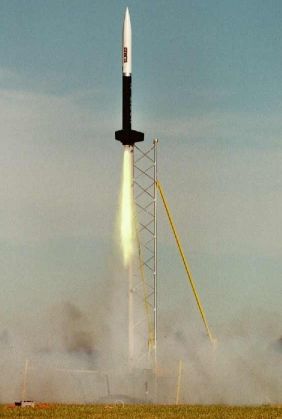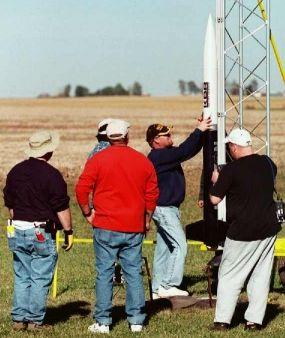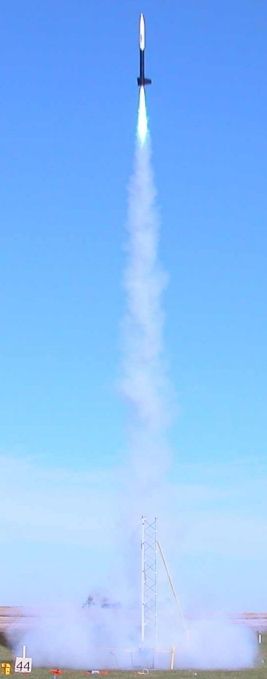BSD High Power Rocketry Horizon (5.5")
BSD High Power Rocketry - Horizon (5.5") {Kit}
Contributed by Clay Kremer
| Construction Rating: | starstarstarstarstar |
| Flight Rating: | starstarstarstarstar |
| Overall Rating: | starstarstarstarstar |
| Manufacturer: | BSD High Power Rocketry  |
 Brief:
Brief:
A 5.5" dual deployment L3 rocket.
Construction:
The kit comes with everything you need except chutes and electronics. It uses
1/4" Baltic birch for the bulkheads, centering rings, and electronics
board. It uses 3/16" Baltic birch for the fins. The airframe is 5.5"
Loc tubing and coupler, the nose cone is plastic. The 5/16" tubular nylon
for the recovery harnesses is included as well as the u-bolts and quick links.
It also comes with a nice set of decals, fiberglass for the fin area, milled
fiber, and a fin alignment guide.
When the box came, everything was neatly packaged and after checking the
parts list everything was there. The instructions are more like a book. Every
step is clearly spelled out and there are a lot of photos of the build.
Building it completely stock and following the instructions was a piece of cake
on the 1st Horizon I built. The only thing that you have to be a little careful
with is cutting the fin slots. I used my compound miter saw and it worked nice
but a sharp X-acto knife would do as well. Since this was my second Horizon and
my Level 3 rocket I decided to do some additional reinforcement. It really
isn't necessary because it is such a well designed kit, and I've seen a  stock Horizons fly on an M1315 (my
brother's Level 3) and it worked out fine. For mine I reinforced all the
couplers, centering rings, avionics board, and fins with 4 layers of 5.7oz
carbon fiber. I also used a layer of carbon inside all of the couplers, added
an additional centering ring and a bulkhead plate in the booster section.
Finally, I added a layer of Kevlar®
around the motor tube, put in two part expanding foam and did tip to tip carbon
on the fins once they were in the airframe. Once again, not necessary but for a
Level 3 I thought overkill OK, and I intend to fly EX loads and some of those
are pretty mean.
stock Horizons fly on an M1315 (my
brother's Level 3) and it worked out fine. For mine I reinforced all the
couplers, centering rings, avionics board, and fins with 4 layers of 5.7oz
carbon fiber. I also used a layer of carbon inside all of the couplers, added
an additional centering ring and a bulkhead plate in the booster section.
Finally, I added a layer of Kevlar®
around the motor tube, put in two part expanding foam and did tip to tip carbon
on the fins once they were in the airframe. Once again, not necessary but for a
Level 3 I thought overkill OK, and I intend to fly EX loads and some of those
are pretty mean.
Finishing:
The kit came with a nice set of decals. I wanted to reverse the paint scheme so
I had some made in reverse of the kit. Since I didn't glass the airframe, it
took several coats of primer to cover the grooves in the tubing but the finish
came out killer.
Construction Rating: 5 out of 5
 Flight:
Flight:
The first flight I did was with an L1120. It was in a three way drag race. It was last off the pad by about a second but roared up perfectly straight and looked like it was going to catch the other rockets. 9800' AGL and perfect recovery. The second flight was my Level 3 attempt. I used an Animal Works M1850 Green Gorilla. Once again a perfectly straight flight. About one second into the flight it was really moving and accelerated hard until motor burnout. Gotta love the AMW tracking smoke! 11,100' and over 1,000 mph.
SUCCESSFUL LEVEL 3 FLIGHT!
October 18, 2003
MWP1
Rocket - BSD 5.5" Horizon
Weight - 18 lbs
Motor - 75mm Animal Motor Works M1850 Green Gorilla
Altitude - 11,100’
Recovery:
The recovery was picture perfect other than a slight zipper at the edge of the
airframe. I have seen a lot of Horizon flights (my brothers each have one and I
have two) and have never seen this before. Very minor and probably a fluke. Not
enough to keep from flying it again or to not get my level 3.
Flight Rating: 5 out of 5
Summary:
This is just a great kit. It flies perfectly straight no matter what you put in
it for a motor. It can weigh as little as 12#'s if built stock or if you are
bored and want to make a tank you can still be under 20#'s. Mine weighed 18#'s.
Can't really think of any cons except if you don't paint it and take it to the
RSO table with an M in it you might get some looks with no glass on the
cardboard tubes.
Please credit Brent Hill for the photos in the article. Also, thanks goes to Dave Zupan and John Clifton for helping me find it in the corn. Dave used a GPS unit and John used a Walston. Dave found it first. It would have been combine fodder without those guys help.
Overall Rating: 5 out of 5
Sponsored Ads
 |
 |











